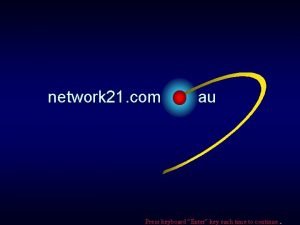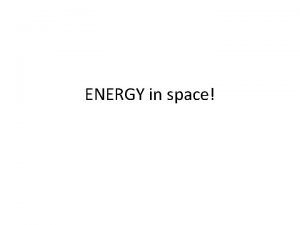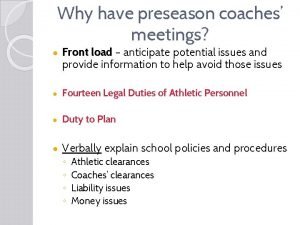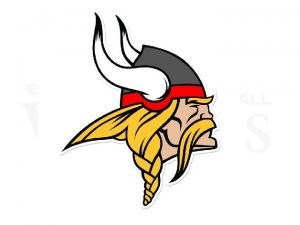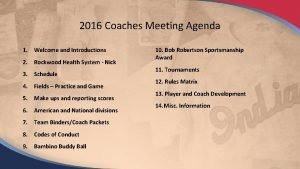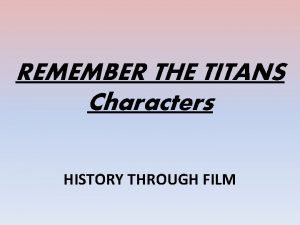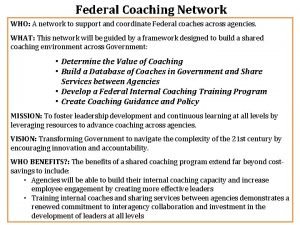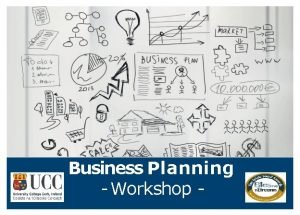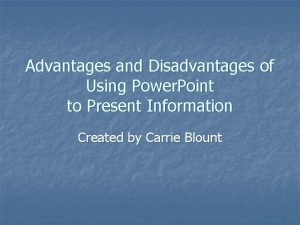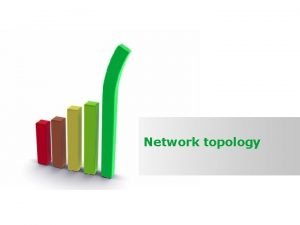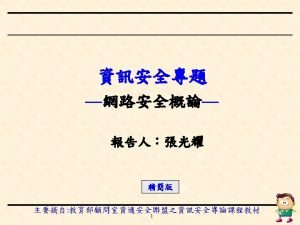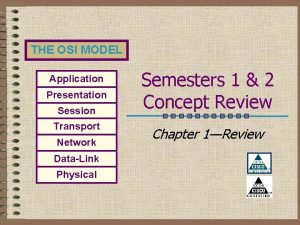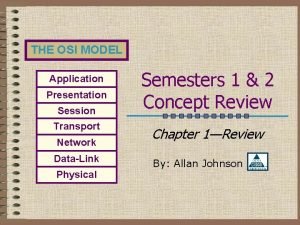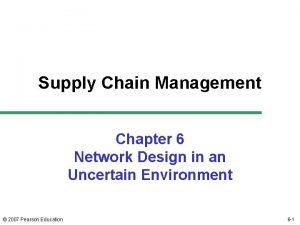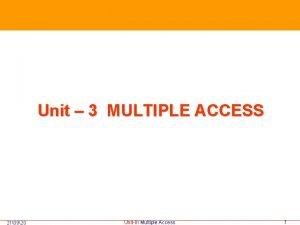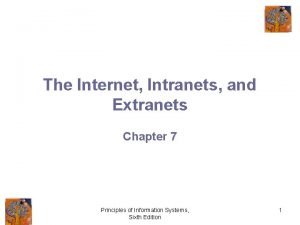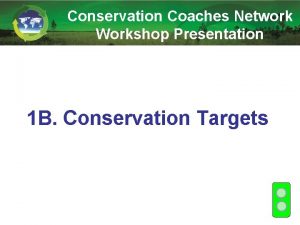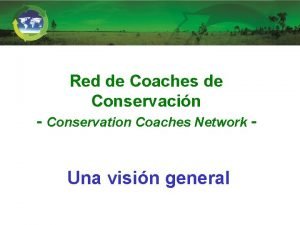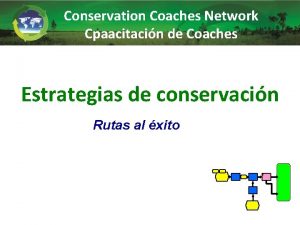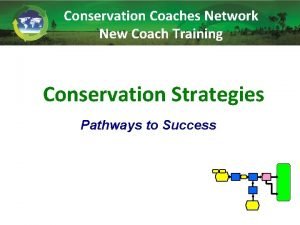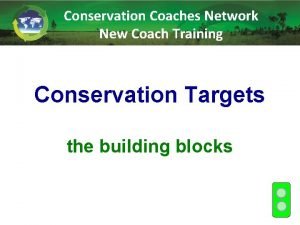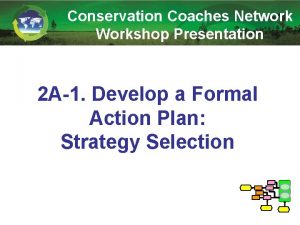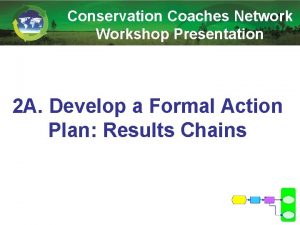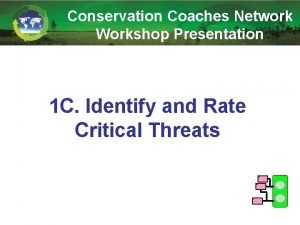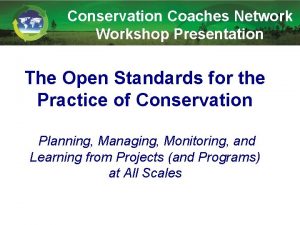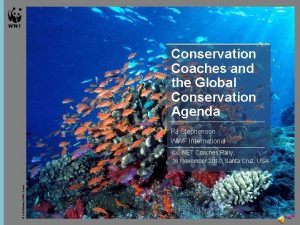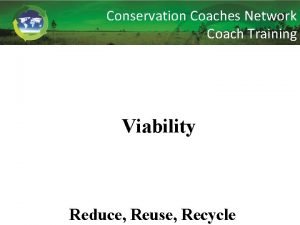Conservation Coaches Network Workshop Presentation 1 D Using













































- Slides: 45

Conservation Coaches Network Workshop Presentation 1 D. Using a Conceptual Model to Document Your Situation Analysis

Adaptive Management Workshop Presentations 1 A-1 B. Team, Scope, Vision 1 B. Conservation Targets 1 B. Viability Assessment 1 C. Threat Rating 2 A-1. Strategy Selection 2 A-2. Results Chains 2 A-3. Goals and Objectives 1 D. Conceptual Models 2 B. Monitoring Plan

Conceptualize Situation Analysis

This Presentation Situation Analysis 1. What Are Situation Analysis and Conceptual Models 2. How to Develop Conceptual Models 3. Adding Human Wellbeing Targets (optional) 4. Examples

What is Situation Analysis? Situation Analysis • A process that will help your project team create together a common understanding of your project’s context – including the biological, environment and the social, economic, political, and institutional systems that affect the conservation targets you want to conserve. • Can be in-depth, formal assessment or less formal description based on available information and/or knowledge of key informants.

What is a Conceptual Model? Situation Analysis A tool for documenting a situation analysis. A diagram that portrays what is happening within a project. It shows the major forces (threats and opportunities) that are influencing biodiversity and lays out the causal relationships among those forces. A good conceptual model…

A Good Conceptual Model: Situation Analysis 1. Presents a picture of your situation 2. Shows assumed relationships between factors 3. Shows major direct threats and indirect threats and opportunities 4. Presents only relevant factors 5. Based on sound data and information 6. Results from a team effort

1. Presents a picture of the situation at the project Situation Analysis

2. Shows assumed linkages between factors Situation Analysis

3. Shows major direct threats and indirect threats & opportunities Indirect Threats & Opportunities (Root Causes): Factors that contribute (positively or negatively) to direct threats Situation Analysis

Situation 4. Presents only relevant factors Analysis

Situation 4. Presents only relevant factors Analysis

Situation 4. Presents only relevant factors Analysis

Situation 4. Presents only relevant factors Analysis

Situation 4. Presents only relevant factors Analysis

Situation 4. Presents only relevant factors Analysis

Situation 4. Presents only relevant factors Analysis

5. Is based on sound data & information • Existing Information • Primary Information Situation Analysis

6. Results from a team effort Situation Analysis

This Presentation Situation Analysis 1. What Are Situation Analysis and Conceptual Models 2. How to Develop Conceptual Models 3. Adding Human Wellbeing Targets (optional) 4. Examples

Our Example – Swan Coastal Plain Wetlands Adapted from WWF Australia’s Weltlands. Watch Project Situation Analysis

Place Your Project Scope, Targets and Direct Threats

Add Contributing Factors Limited awareness of sustainable land management Weak law enforcement

Ineffective policies for wetland management

A growing population that is putting increased pressure on food, water, and land resources

Economic disincentives for organic farming Social acceptance of grazing in wetlands

Don’t Forget to Include Opportunities! Start them with a “+”.

This Presentation Situation Analysis 1. What Are Situation Analysis and Conceptual Models 2. How to Develop Conceptual Models 3. Adding Human Wellbeing Targets (optional) 4. Examples

Recent Addition of (Optional) Human Wellbeing Targets Situation Analysis What people have been saying: • There is no way we can work on project/site X without addressing or recognizing human needs • We have to prove to our constituency that there is a benefit to them beyond biodiversity • Open Standards do not work in complex social situations

What is a Human Wellbeing Target? Situation Analysis Human wellbeing targets focus on those components of human wellbeing affected by the status of conservation targets. *Millennium Ecosystem Assessment defines human wellbeing as including: 1) necessary material for a good life, 2) health, 3) good social relations, 4) security, and 5) freedom and choice

Categories of Human Wellbeing Targets Situation Analysis • Necessary material for a good life: including secure and adequate livelihoods, income and assets, enough food at all times, shelter, furniture, clothing, and access to goods; • Health: including being strong, feeling well, and having a healthy physical environment; • Good social relations: including social cohesion, mutual respect, good gender and family relations, and the ability to help others and provide for children; • Security: including secure access to natural and other resources, safety of person and possessions, and living in a predictable and controllable environment with security from natural and human-made disasters; and • Freedom and choice: including having control over what happens and being able to achieve what a person values doing or being Source: Millennium Ecosystem Assessment This framework is for brainstorming! Actual categories do not matter – just clarity on what a human wellbeing target is.

Link to Conservation Targets via Ecosystem Services Situation Analysis Human wellbeing – in the context of a conservation project – is achieved via ecosystem services provided by functioning conservation targets. For example: Services that intact, functioning ecosystems, species, and habitats provide and that can benefit people

Ecosystem Services Situation Analysis The services that intact, functioning ecosystems, species, and habitats provide and that can benefit people Type Definition Examples Provisioning Products obtained from ecosystems Food, fuelwood, water, minerals, pharmaceuticals, biochemicals, energy Regulating Benefits obtained from regulation of ecosystem processes Carbon sequestration, climate regulation, waste decomposition, water/air purification, crop pollination, pest control Supporting Services necessary for production of all other ecosystem services Nutrient dispersal & cycling, seed dispersal, soil formation Cultural Non-material benefits obtained from ecosystems through spiritual enrichment, cognitive development, reflection, recreation, and aesthetic experiences Cultural diversity, spiritual & religious values, knowledge systems, educational values, inspiration

Relationships Situation Analysis

Example Situation Analysis

This Presentation Situation Analysis 1. What Are Situation Analysis and Conceptual Models 2. How to Develop Conceptual Models 3. Adding Human Wellbeing Targets (optional) 4. Examples

Example: Tropical Forest Site Situation Analysis

Example: Tropical Forest Site Situation Analysis

Example: Tropical Forest Site Situation Analysis

Example: Tropical Forest Site Situation Analysis

Example: Tropical Forest Site Situation Analysis

Example: East African Coastal Forest Situation Analysis

Example: New Mexico, USA Adapted from a real plan Situation Analysis

Key Points to Introduce this Step Situation Analysis A process for analyzing and creating a common understanding of the context of a project & includes biological, social, economic, cultural, political and institutional systems that affect the conservation targets. A conceptual model is one way to document a situation analysis. Content is more important than format. A good conceptual model will greatly facilitate strategy selection. Probe for opportunities, not just threats. You need the right team to develop the model (wide range of expertise) & you need to ask the right questions.

Key Points to Introduce this Step Situation Analysis Situation analysis helps you develop more robust conservation strategies by… – Evaluating factors that are driving the perceived problems – Identifying key individuals/groups (supporters as well as non-supporters) – Articulating and making explicit our understanding of the site conditions – Highlighting points of intervention
 Strategic conservation planning
Strategic conservation planning Conservation coaches network
Conservation coaches network Weekend seminar network 21
Weekend seminar network 21 Ece 526
Ece 526 Kinetic energy formula
Kinetic energy formula Ivi european fund
Ivi european fund Preseason coaches meeting agenda
Preseason coaches meeting agenda Football coaches meeting agenda
Football coaches meeting agenda Trfed
Trfed Kentucky high school golf all state points
Kentucky high school golf all state points Texas cross country coaches association
Texas cross country coaches association Preseason coaches meeting agenda
Preseason coaches meeting agenda Top 10 seo coaches
Top 10 seo coaches Coaches tools psa
Coaches tools psa Basketball coaches meeting agenda
Basketball coaches meeting agenda Characters remember the titans
Characters remember the titans Basketball parent meeting powerpoint
Basketball parent meeting powerpoint Federal coaches
Federal coaches Whitley bay ice rink coaches
Whitley bay ice rink coaches Foley v classique coaches
Foley v classique coaches Health coaches for hypertension control
Health coaches for hypertension control Cobb & co coaches
Cobb & co coaches Newington little league baseball
Newington little league baseball Cifss.org coaches wanted
Cifss.org coaches wanted Business strategy workshop presentation
Business strategy workshop presentation Business continuity plan presentation
Business continuity plan presentation Character reference in resume
Character reference in resume Brow presentation birth
Brow presentation birth Vertex presentation and cephalic presentation
Vertex presentation and cephalic presentation Advantages of power point
Advantages of power point Network topology powerpoint presentation
Network topology powerpoint presentation Osi model
Osi model Convolution neural network ppt
Convolution neural network ppt Application presentation session transport network
Application presentation session transport network Application presentation session transport network
Application presentation session transport network System collections generic
System collections generic Dtfd switch
Dtfd switch Network design decisions using decision trees
Network design decisions using decision trees A network using csma/cd has a bandwidth of 10mbps
A network using csma/cd has a bandwidth of 10mbps Wireless integrated network sensors
Wireless integrated network sensors The is an internal corporate network built using
The is an internal corporate network built using Difference between virtual circuit and datagram network
Difference between virtual circuit and datagram network Network topologies
Network topologies Features of peer to peer network and client server network
Features of peer to peer network and client server network Network centric computing
Network centric computing Disadvantages of circuit switching
Disadvantages of circuit switching


